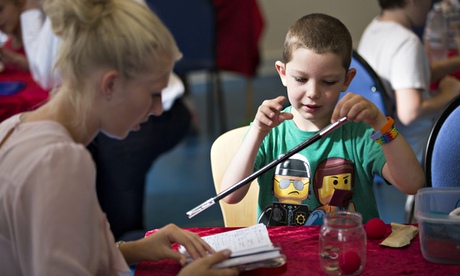
A girl bends over a £20 note, concentrating. Her long hair falls forward. She is trying to fold the note into three, and hook paperclips over the folds. The fingernails of her left hand are painted pink, the right hand blue – a clue that she sees each differently? She spreads the fingers of the blue hand; a disciplinary gesture. She is trying to stretch them into obedience. Then she angles the fingers downwards into a grip, to hold the note steady. The pink ones painstakingly attach the clips as the note bobs waywardly in the blue.
Nancy is eight, and she has come to Guy's hospital in London for Breathe Magic, a summer camp with a difference. For one thing, all the tablecloths are made of red velvet. For two weeks, Nancy and her colleagues will learn and practise tricks before performing at the Magic Circle theatre. The children have hemiplegia, a common form of cerebral palsy that affects muscle control in one half of the body. Some walk with a limp. Some wear calipers (Nancy's pair is leopard print). Most have one hand locked in a position of permanent insubordination – a thumb trapped inside the curl of a palm, fingers clenched into a fist, a wrist that refuses to turn.
"Children with hemiplegia tend to get limited therapy and Botox into the arm," says Yvonne Farquharson, who founded the camp while working as performance arts and health manager at Guy's and St Thomas's charity. She is now managing director at Breathe Arts Health Research, the social enterprise behind Breathe Magic. "There seems to be a lot of rehabilitation until patients can walk. Then, when they can walk, they're deemed OK. Only we know they're not."
At Breathe Magic, the so-called "helper hand", the one that lacks muscle control, has no place to hide. Each child's magic equipment is stored in a box whose lid can only be lifted by two hands. The homework diaries are padlocked. Their snack is a bag of crisps. It is the intensiveness of the therapy – 60 hours over 10 days – that makes it work.
Nancy has persevered and secured the paperclips. Each hand holds one corner of the £20 note. She pulls both sharply in opposite directions. Pink nails go one way, blue nails the other. The "acrobat" paperclips are sprung loose and leap together, dangling in a little chain from a strand of Nancy's hair. She smiles.
The paperclips form just one of many tricks, all of which have been designed to incorporate a movement that children with hemiplegia find tricky. Card tricks improve wrist extension. An illusion in which sponge balls are switched from one palm to another requires forearm supination. Esme, eight, and Ben, six, devotedly stretching out knotted silk scarves until jerky hand movements are secure and fluid, think they are performing magic under the watchful eye of magician Richard McDougall. "Slow is smooth and smooth is fast," he counsels, as yellow silk slithers into red. Of course, the hidden trick within the trick is that Esme and Ben are unconsciously practising large-range movements of the shoulder.
The therapy was the brainchild of David Owen, a former Young Magician of the Year turned QC, who took the idea to Farquharson. Owen's father was a surgeon, his mother a nurse. "I was interested in finding different ways of using magic," he says. "Practising a magic trick has an almost meditative quality, being able to pick something up and do it fluidly with your hands." He says the camp is "using magic as metaphor. It's a way of dealing with communication."
That has certainly been the experience of George Say, 16, an attendee in 2010, returning this year as a mentor. Unlike Nancy, whom her mother, Tracey Davies, describes as "a confident child", George was bullied at primary and secondary school. "I couldn't play football with boys where I lived, or ride bikes with them. I was always too slow," he says. "As soon as I got to magic camp I was fine. I just felt so, so good. For once I could be myself and not be judged. I thought: you know what? This is me. If other people don't like it, fine. I'll never be 'normal'. But – there's no such thing as normal." He smiles, as if in one move he has discovered something and vanished it.
"I've still got my old box of tricks. I've got my cape and my top hat," George says. "On my way home on the train, if the person opposite is staring straight ahead, I'll start doing tricks. No words. Just visual. That would never have happened before. My anxiety was through the roof. I wouldn't be on my own for anything. I used to shake a lot." He holds out both hands, palms down, as though he is about to perform one last trick. They remain obediently still. Not a tremor.
Magic is built on the idea of transformation, so perhaps it is unsurprising that magic therapy is transformative. Davies lists the things that Nancy can do this week that she could not do last. "She'll put toothpaste on her toothbrush. She can do up her shoelaces. She'll happily open up a carton of milk …"
But perhaps the greatest surprise, the real rabbit out of the hat, is that the children have learned to do such ordinary tasks by mastering something extraordinary. They have learned to do not only the boring stuff that everyone can do, but magic that few others can. And they have learned to believe that, sometimes, what seems impossible is only a perfectible sleight of hand.

